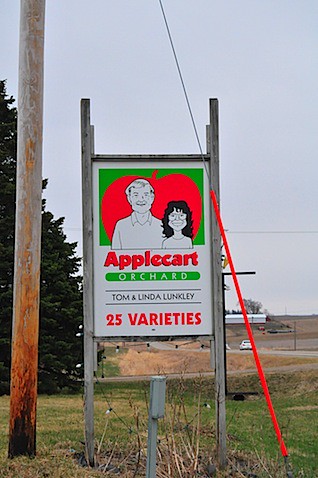
Quick: how many different varieties of apples can you name in 10 seconds? I'll try as well.
Golden Delcious
Red Delicious
Gala
Braeburn
Fuji
Pink Lady
And...stop. How many did I get, 6? And I know my apples. Over at Applecart Orchards, Allen Isreal grows over 35 varieties of apples-from standards like red delicious and gala's to more esoteric varieties, such as arkansas black and blushing goldens. That isn't all his 35 acres contains though- he also manages to grow 4 varieties of peaches and 7 varieties of pears (of those, he has 5 different varieties of asian pears). Even the winter is no barrier to biological diversity over at Applecart. In his 2 greenhouses he grows 7 or 8 different varieties of lettuce, esoteric vegetables (kohlrabi, bak choi) and more tomatoes than I could even imagine. Allen didn't brag about the orchard of eden he has created on his small farm in Vinton, just west of cedar rapids, although as I strolled around the orchard, I could feel his pride in the variety by which he was surrounded.
I should back up and mention the mechanism by which I met Allen: at a winter farmers market Iowa City. When I walked by his orchard's stand, I was dazzled by the array of apples. As I talked to him, I realized that he was a man who knew, not just the names of his apples, but the flavors as well. When I asked him about what type of apple to get, he peppered me with questions like "Do you like sweet or tart apples?" and "How do you feel about _______" where the blank would, invariably, be an off the road variety which I barely knew. As I left, I was sure to snag his card, confident that the hour and a half drive to Vinton would be worth it, even if he didn't have any more than the 6 or 7 varieties of apples he had with him that day.
Anyway, when I arrived at the farm last Thursday I was not disappointed. He took me briefly through the store, which also houses an apple sorter and a cider press, in the back. In the storage room he asked me what type of apple I would like, red delicious or blushing golden, and I grabbed the latter. And thus, chomping happily on the fruit (I later found out it had been in storage since october-some apples are still good up to a year later with careful storage) we walked into the greenhouse, which contained the aforementioned sprouts of various lettuces, tomatoes, herb and vegetables.
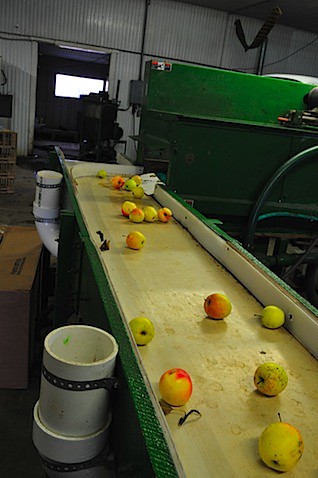
In the warm, humid air of the greenhouse Allen explained the variety of lettuces he was growing, along with well informed editorials about their flavor. I was amazed he could even remember the names of all the plants, let alone their culinary qualities. He showed me a few new varieties he was trying; mostly exotics like kohlrabi, red bak choi and sweet basil (also called thai basil). Multiple times, he invited me to grab a little seedling and bite the top of it off to taste a particularly unique flavor. it was a grand old time.

Above: Tons of lettuce! Or at least tons of lettuce sprouts. Note the variety.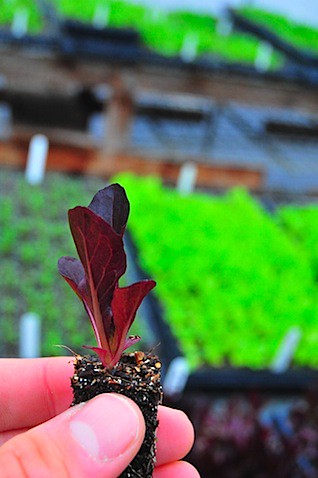
Above: A tender shoot of red romaine lettuce, just before I popped it into my mouth. Nom nom nom!
As we exited the greenhouse and walked through the rows of gnarled apple trees, he talked about the pruning process; something about which I now very little. Allen is a very careful pruner, removing the older branches so as to allow the tree as much sunlight as possible, which produces better fruit. This careful pruning also pays off: the trees last longer. A tree, he explained, is only as old as its wood. By pruning carefully, so that the branches are quite young (3 or 4 years old, on average) he extended the lifespan of his trees to about 25. He doesn't think much of this. However, I happen to remember that Hinegardner's Orchards expects its trees to last 15 years at the maximum.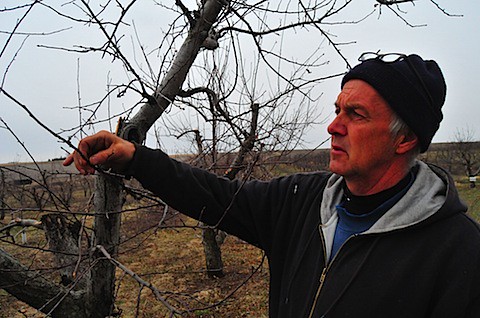
Above: Allen Isreal explains the dynamics of pruning and apple production. He is a wonderful teacher; full of interesting facts, he understatedly imparted knowledge to me during the entire tour.
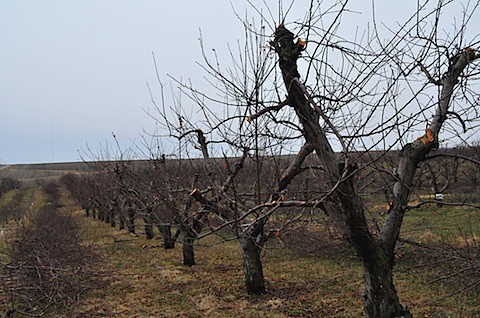
Above: a row of pruned apple trees. They look sad now, but they will be happy come summer, when the Sun's warming rays reach all the leaves.

Above: an un-pruned apple tree.
As we walked slowly towards the end of the orchard, we passed a pet project of his, 3 rows of asparagus. Strolling back, he talked about the health of his trees in relationship to this year's winter. It was particularly bad, he said, and had reached temperatures of around 35 below zero in the orchard. While his apple trees were mostly fine, none of his peaches (which are only good to -25 degrees) would be producing fruit that year- if it gets to cold the tree spends its energy repairing, not producing.
On the other side of the greenhouses he showed me another work in progress: the pears. He has 5 varieties of asian pears, with names like Golden Olympic (that type I remember; he said it tasted lightly of caramel). In addition, he has 2 varieties of normal pears.
I left, slightly disappointed I had not discovered this array of fruitly pleasure earlier. I would have gorged myself on tomatoes, lettuce, pears, apples and peaches, as well as loaded my car full to bursting. As it is, he can expect to see me at his booth, come summer.
1 comment:
I've been there and it's a great place to visit in the fall when the apples are in bloom!! Can't wait to go this year!!
Post a Comment